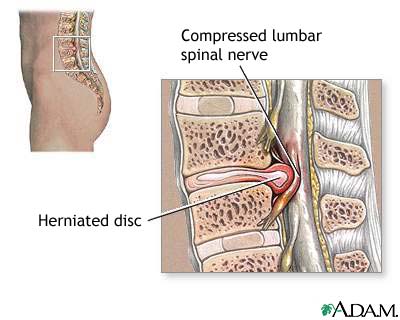Disc Bulge, Herniation & Prolapse: Causes, Symptoms & Treatment Options. Do You Have A Question? Speak To A Therapist Today. Call (24/7): 1300-003-777.
I’m sure you’ve heard the terms disc herniation, pinched nerve, bulging disc, disc prolapse, ruptured disc or slipped disc. These common phrases are used to describe disc injuries. Chances are if you’re suffering a spinal disc injury then you’re experiencing burning, shooting or aching pain accompanied with numbness, tingling and muscle weakness. Characteristic signs of a lower back disc injury include abnormal posture (referred to as antalgic posture), altered walking pattern, reduced movement and general stiffness. Disc injuries may cause nerve root entrapment. Nerve root entrapment is when a disc directly presses on a nerve. These types of problems can occur anywhere in the spine however are most commonly experienced in the lower neck and lower back.
Why Do We Need Spinal Discs?
The interveterbral disc is responsible for acting as a shock absorber for the spine. Each disc allows the spine mobility and flexibility to bend. There are a total of 23 discs that separate each vertebrae of the spinal column except for between the top two bones in the neck. Each disc is divided into two components, a soft spongy inner (nucleus pulposes) and hard outer (annulus fibrosis) layer. Damage to either of these layers can contribute to pain in any area of the spine. At birth each disc has a high water content which decreases as we get older. This leads to a more rigid, firm and less flexible disc. This process contributes to the development of disc degeneration. Disc degeneration can be prevented through proper exercise, nutrition as well as other strategies to look after your spine such as Chiropractic care.
Symptoms Of A Bulging Disc
- Neck pain & stiffness
- Shoulder, arm or hand pain
- Numbness, weakness & tingling
- Lower back pain & stiffness
- Buttock, thigh, leg & foot pain
- Antalgic posture
- Pain that worsens when bending, lifting or straining
Risk Factors For Developing A Disc Injury
There are a variety of predisposing risk factors including being overweight or obese, inadequate supporting muscular strength, ageing, poor posture (rounded shoulders, forward head position, pelvic tilt, pelvic unleveling, scoliosis), incorrect lifting techniques as well as occupations that require prolonged sitting that may enhance your chances of suffering disc injuries. If you’re suffering additional symptoms including saddle paraesthesia, bowel/bladder dysfunction, neurological deficit, sudden onset of pain following a traumatic event or presence of significant muscle atrophy (weakness and wasting) than it’s recommended that you consult immediate medical attention.
Herniated Disc, Slipped Disc Or Disc Protrusion Treatment
Depending upon the exact cause of you pain, location and pathophysiology there are a variety of techniques to treat a disc bulge.
Chiropractic
- Manual joint manipulation involves moving joints to realign & reposition to therefore reduce pressure upon a disc bulge.
- Joint mobilisation is a gentle treatment option in cases that are particularly acute and severe. Mobilisation involves stretching and opening joints to improve overall movement and assist tissue healing.
- Traction therapy is particularly favored in cases of lumbar disc bulges.
Massage
Massage will not directly promote healing of your disc bulge however it will assist the surrounding muscles and soft tissues of the injured area.
Anti-Inflammatory Medications
In particular circumstances anti-inflammatory medications may be advised to assist with reducing your pain. Unfortunately such medications do no assist healing, but in the short-term they will assist with making life a little easier.
Cortisone Injections
Cortisone injections are useful for relieving pain that is associated with a disc bulge. Cortisone is a potent anti-inflammatory and can be injected directly into the site of injury. It’s important to recognize that like all treatment, some people do not respond successfully so be sure to look at all other treatment options before considering this approach.
Surgery
If all other options have been exhausted and you have not responded to treatment, surgical intervention may be indicated to remove your injured disc or fuse surrounding vertebrae. It’s important to recognize that risks exist with any procedure so be sure to discuss these with your doctor.
Chiropractor Disc Bulge Research
- Given majority of patients suffering disc pathology will improve following non-operative therapies such as Chiropractic, a trial of conservative management is warranted before examining operative techniques. Daffner, S (2010). Cost and use of conservative management of lumbar disc herniation before surgical discectomy. The Spine Journal, 10(6); 463-468
- A large percentage of acute and chronic lumbar disc bulge treatment patients using Chiropractic care demonstrated clinical significant improvements, with no adverse events. Leeman, S (2014). Outcomes of acute and chronic patients with magnetic resonance imaging – confirmed symptomatic lumbar disc herniations receiving high-velocity, low amplitude spinal manipulative therapy: A prospective observational cohort study with one year follow up. Journal of Manipulative Physiological Therapeutics, 37(3); 155 – 163

